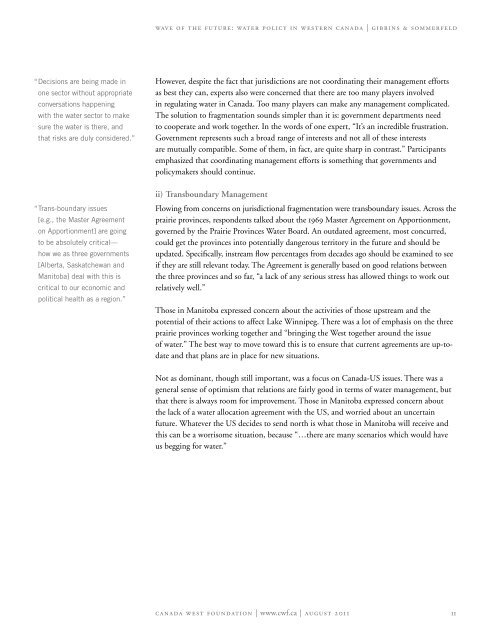Wave Future
Waveof theFuture water policy in western canada - Canada West ...
Waveof theFuture water policy in western canada - Canada West ...
- No tags were found...
Create successful ePaper yourself
Turn your PDF publications into a flip-book with our unique Google optimized e-Paper software.
wave of the future: water policy in western canada | gibbins & sommerfeld<br />
“ Decisions are being made in<br />
one sector without appropriate<br />
conversations happening<br />
with the water sector to make<br />
sure the water is there, and<br />
that risks are duly considered.”<br />
“ Trans-boundary issues<br />
[e.g., the Master Agreement<br />
on Apportionment] are going<br />
to be absolutely critical—<br />
how we as three governments<br />
[Alberta, Saskatchewan and<br />
Manitoba] deal with this is<br />
critical to our economic and<br />
political health as a region.”<br />
However, despite the fact that jurisdictions are not coordinating their management efforts<br />
as best they can, experts also were concerned that there are too many players involved<br />
in regulating water in Canada. Too many players can make any management complicated.<br />
The solution to fragmentation sounds simpler than it is: government departments need<br />
to cooperate and work together. In the words of one expert, “It’s an incredible frustration.<br />
Government represents such a broad range of interests and not all of these interests<br />
are mutually compatible. Some of them, in fact, are quite sharp in contrast.” Participants<br />
emphasized that coordinating management efforts is something that governments and<br />
policymakers should continue.<br />
ii) Transboundary Management<br />
Flowing from concerns on jurisdictional fragmentation were transboundary issues. Across the<br />
prairie provinces, respondents talked about the 1969 Master Agreement on Apportionment,<br />
governed by the Prairie Provinces Water Board. An outdated agreement, most concurred,<br />
could get the provinces into potentially dangerous territory in the future and should be<br />
updated. Specifically, instream flow percentages from decades ago should be examined to see<br />
if they are still relevant today. The Agreement is generally based on good relations between<br />
the three provinces and so far, “a lack of any serious stress has allowed things to work out<br />
relatively well.”<br />
Those in Manitoba expressed concern about the activities of those upstream and the<br />
potential of their actions to affect Lake Winnipeg. There was a lot of emphasis on the three<br />
prairie provinces working together and “bringing the West together around the issue<br />
of water.” The best way to move toward this is to ensure that current agreements are up-todate<br />
and that plans are in place for new situations.<br />
Not as dominant, though still important, was a focus on Canada-US issues. There was a<br />
general sense of optimism that relations are fairly good in terms of water management, but<br />
that there is always room for improvement. Those in Manitoba expressed concern about<br />
the lack of a water allocation agreement with the US, and worried about an uncertain<br />
future. Whatever the US decides to send north is what those in Manitoba will receive and<br />
this can be a worrisome situation, because “…there are many scenarios which would have<br />
us begging for water.”<br />
canada west foundation | www.cwf.ca | august 2011<br />
11




